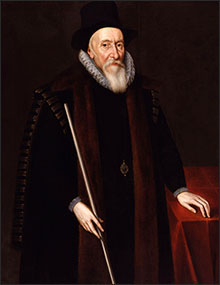|
|
|
|


Thomas Sackville, Lord Buckhurst and first Earl of Dorset, was the son of Sir Richard Sackville, and was born at Withyam,
in Sussex. He was educated at both universities, and enjoyed an early reputation in Latin as well as in English poetry. While a student of the Inner Temple, he wrote his tragedy of
Gorboduc, which was played by the young students, as a part of a Christmas entertainment, and afterwards before Queen Elizabeth I at Whitehall, in 1561.
In a subsequent edition of this piece it was entitled the tragedy of Ferrex and Porrex. He is said to have been assisted in the composition of it by Thomas Norton; but to what extent
does not appear. T. Warton disputed the fact of his being at all indebted to Norton. The merit of the piece does not render the question of much importance.
This tragedy and his contribution of the Induction and legend of the Duke of Buckingham to the "Mirror for Magistrates," compose the poetical history of Sackville's life.
The rest of it was political. He had been elected to parliament at the age of thirty. Six years afterwards, in the same year that his Induction and legend of Buckingham
were published, he went abroad on his travels, and was, for some reason that is not mentioned, confined, for a time, as a prisoner at Rome; but he returned home, on the
death of his father, in 1566, and was soon after promoted to the title of Lord Buckhurst. Having entered at first with rather too much prodigality on the enjoyment of
his patrimony, he is said to have been reclaimed by the indignity of being kept in waiting by an alderman, from whom he was borrowing money, and to have made a resolution
of economy, from which he never departed.
The Queen employed him, in the fourteenth year of her reign, in an embassy to Charles IX of France. In 1587 he went as ambassador to the United Provinces, upon their
complaint against the Earl of Leicester; but, though he performed his trust with integrity, the favourite
had sufficient influence to get him recalled; and on his return, he was ordered to confinement in his own house, for nine or ten months. On Leicester's death, however, he
was immediately reinstated in royal favour, and was made Knight of the Garter, and Chancellor of Oxford. On the death of Burleigh
he became Lord High Treasurer of England.
At Queen Elizabeth's demise he was one of the Privy Counsellors on whom the administration of the kingdom devolved, and he concurred in proclaiming
King James. The new sovereign confirmed him in the office of High Treasurer by a patent for life,
and on all occasions consulted him with confidence. In March, 1604, he was created Earl of Dorset. He died suddenly at the council table, in consequence of a dropsy
on the brain [stroke]. Few ministers, as Lord Orford remarks, have left behind them so unblemished a character. His family considered his memory so invulnerable,
that when some partial aspersions were thrown upon it, after his death, they disdained to answer them. He carried taste and elegance even into his formal political
functions, and for his eloquence was styled the belle of the Star Chamber.
As a poet, his attempt to unite allegory with heroic narrative, and his giving our language its earliest regular tragedy, evince the views and enterprize of no
ordinary mind; but, though the induction to the Mirror for Magistrates displays some potent sketches, it bears the complexion of a saturnine genius,
and resembles a bold and gloomy landscape on which the sun never shines. As to Gorboduc, it is a piece of monotonous recitals, and cold and heavy accumulation
of incidents. As an imitation of classical tragedy it is peculiarly unfortunate, in being without even the unities of place and time, to circumscribe its dulness.
Excerpted from:
Campbell, Thomas. Specimens of the British Poets, Vol. II.
London: John Murray, 1819. 134-137.
 | to Thomas Sackville |
Site copyright ©1996-2018 Anniina Jokinen. All Rights Reserved.
Created by Anniina Jokinen on August 1, 2006. Last updated December 17, 2018.
|
|
The Tudors
King Henry VII
Elizabeth of York
King Henry VIII
Queen Catherine of Aragon
Queen Anne Boleyn
Queen Jane Seymour
Queen Anne of Cleves
Queen Catherine Howard
Queen Katherine Parr
King Edward VI
Lady Jane Grey
Queen Mary I
Queen Elizabeth I
Renaissance English Writers
Bishop John Fisher
William Tyndale
Sir Thomas More
John Heywood
Thomas Sackville
John Bale
Nicholas Udall
John Skelton
Sir Thomas Wyatt
Henry Howard
Hugh Latimer
Thomas Cranmer
Roger Ascham
Sir Thomas Hoby
John Foxe
George Gascoigne
John Lyly
Thomas Nashe
Sir Philip Sidney
Edmund Spenser
Richard Hooker
Robert Southwell
Robert Greene
George Peele
Thomas Kyd
Edward de Vere
Christopher Marlowe
Anthony Munday
Sir Walter Ralegh
Thomas Hariot
Thomas Campion
Mary Sidney Herbert
Sir John Davies
Samuel Daniel
Michael Drayton
Fulke Greville
Emilia Lanyer
William Shakespeare
Persons of Interest
Visit Encyclopedia
Historical Events
Field of the Cloth of Gold, 1520
Pilgrimage of Grace, 1536
The Babington Plot, 1586
The Spanish Armada, 1588
Elizabethan Theatre
See section
English Renaissance Drama
Images of London:
London in the time of Henry VII. MS. Roy. 16 F. ii.
London, 1510, the earliest view in print
Map of England from Saxton's Descriptio Angliae, 1579
Location Map of Elizabethan London
Plan of the Bankside, Southwark, in Shakespeare's time
Detail of Norden's Map of the Bankside, 1593
Bull and Bear Baiting Rings from the Agas Map (1569-1590, pub. 1631)
Sketch of the Swan Theatre, c. 1596
Westminster in the Seventeenth Century, by Hollar
Visscher's Panoramic View of London, 1616. COLOR
|
|